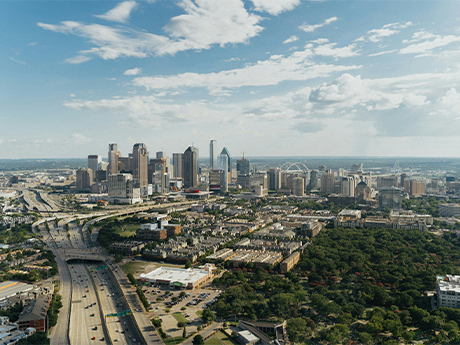The multifamily sector in Dallas-Fort Worth has faced a challenging capital market environment over the past year. But like its counterparts in the Sun Belt, the local market has proven to be resilient based on economic performance, employment and population growth, as well as other market fundamentals.
Sentiments about the commercial real estate sector in Dallas-Fort Worth, as a result, have turned very positive since the start of the year, though a significant number of investors remain cautiously optimistic.
Employment indicators in Dallas-Fort Worth best displayed the resilience we saw throughout most of 2023. The metroplex soared to a record high of 4.3 million people employed and led the country in job growth by adding more than 134,000 jobs, marking a year-over-year increase of 3.2 percent.
Additionally, the local population increased by 132,083 residents, bringing the total to 8.1 million residents at the end of the year. The influx of jobs and people speaks to the region’s economic vitality amid broader macroeconomic headwinds while also naturally providing a boost to the local multifamily sector.
Another good indicator of the market’s performance and economic viability is the U.S. 10-year Treasury yield, which impacts cap rates and valuations for multifamily and commercial real estate properties. As 2023 ended, the treasury yield touched 3.78 percent, a level not seen since July and down from a recent high of 5.02 percent in October 2023.
There has been some fluctuation with the rate throughout February and March, which then rose to 4.6 percent as of late-April. Despite the fluctuations in the treasury, investors maintain a positive outlook and are eagerly seeking to invest capital in promising opportunities.
Population Growth Will Anchor Long-Term Renter Demand
The remarkable population growth across the metroplex has generated a consistent demand for new properties.
In fact, the market saw positive net absorption with a total of 9,084 units absorbed in the market during 2023’s final quarter. North and South Fort Worth secured the top two spots for most units absorbed in 2023, followed by Frisco and other neighboring submarkets like Allen/ McKinney.
Dallas-Fort Worth saw a year-over-year rent decrease of 1.5 percent by the end of the fourth quarter of 2023. This is to be expected due to new supply coming online coupled with the rent growth experienced during the back half of 2021 and first half of 2022 when effective rental rates (including concessions) increased from single to then double digits and marked a peak period for the local multifamily market.
Rents will begin to normalize in 2025 when multifamily deliveries peak and supply begins to taper. Other markets across the Sun Belt are experiencing the same softness, but Dallas-Fort Worth will begin to find the equilibrium between the large amounts of supply in the pipeline and rent growth. A vast amount of supply will begin being absorbed, and that along with the massive pullback in construction starts will result in fewer deliveries than usual during the back half of 2025 through 2027.
Construction Decline Will Push Up Rents
The multifamily pipeline in Dallas-Fort Worth points to potential growth opportunities in the future for the area with consistent population influx and the need for units to house new residents. Developers were building 69,370 units at the end of 2023, with the expectation that 50,000 units will deliver in 2024.
Given the falloff in deliveries expected in 2025 through 2027, we will see positive upward pressure in rent growth and outsized absorption with minimal concessions. Construction starts have been impacted by tighter lending standards, rising hard costs and a lack of joint venture equity available due to valuations dipping beneath replacements costs, which has created a massive pullback in starts.
Developers have also encountered longer wait times for securing the necessary permits and entitlements on capitalized deals. With fewer developers going vertical, this makes for a very attractive supply and demand scenario in the years to come.
Multifamily remains a compelling investment opportunity, and Dallas-Fort Worth continues to outpace comparable national markets in this respect for investors. In 2023, Dallas ranked as one of the leading cities in the United States for commercial real estate investment volume, even though its sales volume decreased by 58 percent compared to 2022.
More than $9 billion, representing roughly half of the market’s commercial transactions, was focused on the multifamily sector. Investors view Dallas-Fort Worth as a resilient, Tier-1 market that has been underscored by the phenomenal amount of capital migration.
The market is continually adjusting to new realities while upholding its fundamental strengths. Despite lingering challenges — such as fluctuating interest rates, the need for absorption to play catchup from a post-pandemic construction boom and a challenging operational climate caused by factors like high insurance costs and minimized rent growth — data indicates the worst is behind us.
The market appears to be primed for growth moving forward. Throughout 2024, we can expect the market to further improve as the outlook remains positive, capital becomes more active and both buyers and sellers remain eager to find common ground on deals.
— Grant Raymond is senior director with Cushman & Wakefield’s Sunbelt Multifamily Advisory Group. He is based in Dallas. Market figures in this article were published in Cushman & Wakefield’s fourth-quarter 2023 Dallas multifamily report, which pulls data from RealPage and MSCI. This article originally appeared in the March/April issue of Texas Multifamily & Affordable Housing Business.


